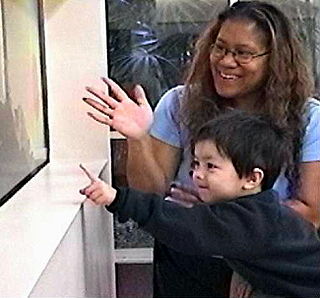
Asperger syndrome (AS), also known as Asperger's syndrome or Asperger's, is a term formerly used to describe a neurodevelopmental disorder characterized by significant difficulties in social interaction and nonverbal communication, along with restricted, repetitive patterns of behavior and interests. Asperger syndrome has been merged with other disorders into autism spectrum disorder (ASD) and is no longer considered a stand-alone diagnosis. It was considered milder than other diagnoses which were merged into ASD due to relatively unimpaired spoken language and intelligence.
Developmental disorders comprise a group of psychiatric conditions originating in childhood that involve serious impairment in different areas. There are several ways of using this term. The most narrow concept is used in the category "Specific Disorders of Psychological Development" in the ICD-10. These disorders comprise developmental language disorder, learning disorders, motor disorders, and autism spectrum disorders. In broader definitions ADHD is included, and the term used is neurodevelopmental disorders. Yet others include antisocial behavior and schizophrenia that begins in childhood and continues through life. However, these two latter conditions are not as stable as the other developmental disorders, and there is not the same evidence of a shared genetic liability.

Diagnoses of autism have become more frequent since the 1980s, which has led to various controversies about both the cause of autism and the nature of the diagnoses themselves. Whether autism has mainly a genetic or developmental cause, and the degree of coincidence between autism and intellectual disability, are all matters of current scientific controversy as well as inquiry. There is also more sociopolitical debate as to whether autism should be considered a disability on its own.

Neurodiversity is a framework for understanding human brain function that recognizes the diversity of human cognition as a biological fact. The neurodiversity paradigm argues that diversity in human cognition is normal and that some conditions classified as mental disorders are differences and disabilities that are not necessarily pathological.
Ole Ivar Løvaas was a Norwegian-American clinical psychologist and professor at the University of California, Los Angeles. He is most well known for his research on what is now called applied behavior analysis (ABA) to teach autistic children through prompts, modeling, and positive reinforcement. The therapy is also noted for its use of aversives (punishment) to reduce undesired behavior, however these are now used less commonly than in the past.

Michelle Dawson is a Canadian autism researcher who was diagnosed with autism in 1993–1994. Since 2004, she has worked as an autism researcher affiliated with the Autism Specialized Clinic of Hôpital Rivière-des-Prairies in Montreal, Quebec, Canada.
Discrete trial training (DTT) is a technique used by practitioners of applied behavior analysis (ABA) that was developed by Ivar Lovaas at the University of California, Los Angeles (UCLA). DTT uses mass instruction and reinforcers that create clear contingencies to shape new skills. Often employed as an early intensive behavioral intervention (EIBI) for up to 25–40 hours per week for children with autism, the technique relies on the use of prompts, modeling, and positive reinforcement strategies to facilitate the child's learning. It previously used aversives to punish unwanted behaviors. DTT has also been referred to as the "Lovaas/UCLA model", "rapid motor imitation antecedent", "listener responding", errorless learning", and "mass trials".
The UC Davis MIND Institute is a research and treatment center affiliated with the University of California, Davis, with facilities located on the UC Davis Medical Center campus in Sacramento, California. The institute is a consortium of scientists, educators, physicians and parents dedicated to researching the causes of and treatments for autism spectrum disorders, fragile X syndrome, and other neurodevelopmental disorders. The director of the MIND institute is Dr. Leonard Abbeduto.
Applied behavior analysis (ABA), also called behavioral engineering, is a psychological intervention that applies approaches based upon the principles of respondent and operant conditioning to change behavior of social significance. It is the applied form of behavior analysis; the other two forms are radical behaviorism and the experimental analysis of behavior.
High-functioning autism (HFA) was historically an autism classification where a person exhibits no intellectual disability, but may experience difficulty in communication, emotion recognition, expression, and social interaction.
The following outline is provided as an overview of and topical guide to autism:

Autism therapies include a wide variety of therapies that help people with autism, or their families. Such methods of therapy seek to aid autistic people in dealing with difficulties and increase their functional independence.
Pivotal response treatment (PRT), also referred to as pivotal response training, is a naturalistic form of applied behavior analysis used as an early intervention for children with autism that was pioneered by Robert Koegel and Lynn Kern Koegel. PRT advocates contend that behavior hinges on "pivotal" behavioral skills—motivation and the ability to respond to multiple cues—and that development of these skills will result in collateral behavioral improvements. In 2005, Richard Simpson of the University of Kansas identified pivotal response treatment as one of the four scientifically based treatments for autism.
The professional practice of behavior analysis is a domain of behavior analysis, the others being radical behaviorism, experimental analysis of behavior and applied behavior analysis. The practice of behavior analysis is the delivery of interventions to consumers that are guided by the principles of radical behaviorism and the research of both experimental and applied behavior analysis. Professional practice seeks to change specific behavior through the implementation of these principles. In many states, practicing behavior analysts hold a license, certificate, or registration. In other states, there are no laws governing their practice and, as such, the practice may be prohibited as falling under the practice definition of other mental health professionals. This is rapidly changing as behavior analysts are becoming more and more common.

Classic autism, also known as childhood autism, autistic disorder, (early) infantile autism, infantile psychosis, Kanner's autism, Kanner's syndrome, or (formerly) just autism, is a neurodevelopmental condition first described by Leo Kanner in 1943. It is characterized by atypical and impaired development in social interaction and communication as well as restricted, repetitive behaviors, activities, and interests. These symptoms first appear in early childhood and persist throughout life.

Autism, also called autism spectrum disorder (ASD) or autism spectrum condition (ASC), is a neurodevelopmental disorder marked by deficits in reciprocal social communication, along with restricted and repetitive patterns of behavior. Other common signs include difficulties with social interaction, verbal and nonverbal communication, and the presence of perseverative interests, stereotypic body movements (stimming), rigid routines, and hyper- or hyporeactivity to sensory input. Autism is clinically regarded as a spectrum disorder, meaning that it can manifest very differently in each person. For example, some are nonspeaking, while others have proficient spoken language. Because of this, there is wide variation in the support needs of people across the autism spectrum.
Geraldine Dawson is an American child clinical psychologist, specializing in autism. She has conducted research on early detection, brain development, and treatment of autism spectrum disorders (ASD) and collaborated on studies of genetic risk factors in autism. Dawson is William Cleland Distinguished Professor of Psychiatry and Behavioral Sciences and professor of psychology and neuroscience, former director, Duke Institute for Brain Sciences and founding director of the Duke Center for Autism and Brain Development at Duke University Medical Center. Dawson was president of the International Society for Autism Research, a scientific and professional organization devoted to advancing knowledge about autism spectrum disorders. From 2008 to 2013, Dawson was research professor of psychiatry at the University of North Carolina at Chapel Hill and was chief science officer for Autism Speaks. Dawson also held the position of adjunct professor of psychiatry at Columbia University and is professor emerita of psychology at University of Washington. She is a fellow of the American Psychological Society, American Psychological Association, International Society for Autism Research, and the Society of Clinical Child and Adolescent Psychology.
The history of autism spans over a century; autism has been subject to varying treatments, being pathologized or being viewed as a beneficial part of human neurodiversity. The understanding of autism has been shaped by cultural, scientific, and societal factors, and its perception and treatment change over time as scientific understanding of autism develops.
Autistic masking, also referred to as camouflaging or neurodivergent masking, is the conscious or subconscious suppression of autistic behaviors and compensation of difficulties in social interaction by autistic people with the goal of being perceived as neurotypical. Masking is a learned coping strategy that can be successful from the perspective of autistic people, but can also lead to adverse mental health outcomes.
The Early Start Denver Model (ESDM) is a form of intervention directed at young children that display early signs of being on the autism spectrum proposed by American psychiatrists Sally J. Rogers and Geraldine Dawson. It is intended to help children improve development traits as early as possible so as to narrow or close the gaps in capabilities between the individual and their peers.





